coolant VOLKSWAGEN GOLF 2009 Owners Manual
[x] Cancel search | Manufacturer: VOLKSWAGEN, Model Year: 2009, Model line: GOLF, Model: VOLKSWAGEN GOLF 2009Pages: 516, PDF Size: 105.12 MB
Page 102 of 516
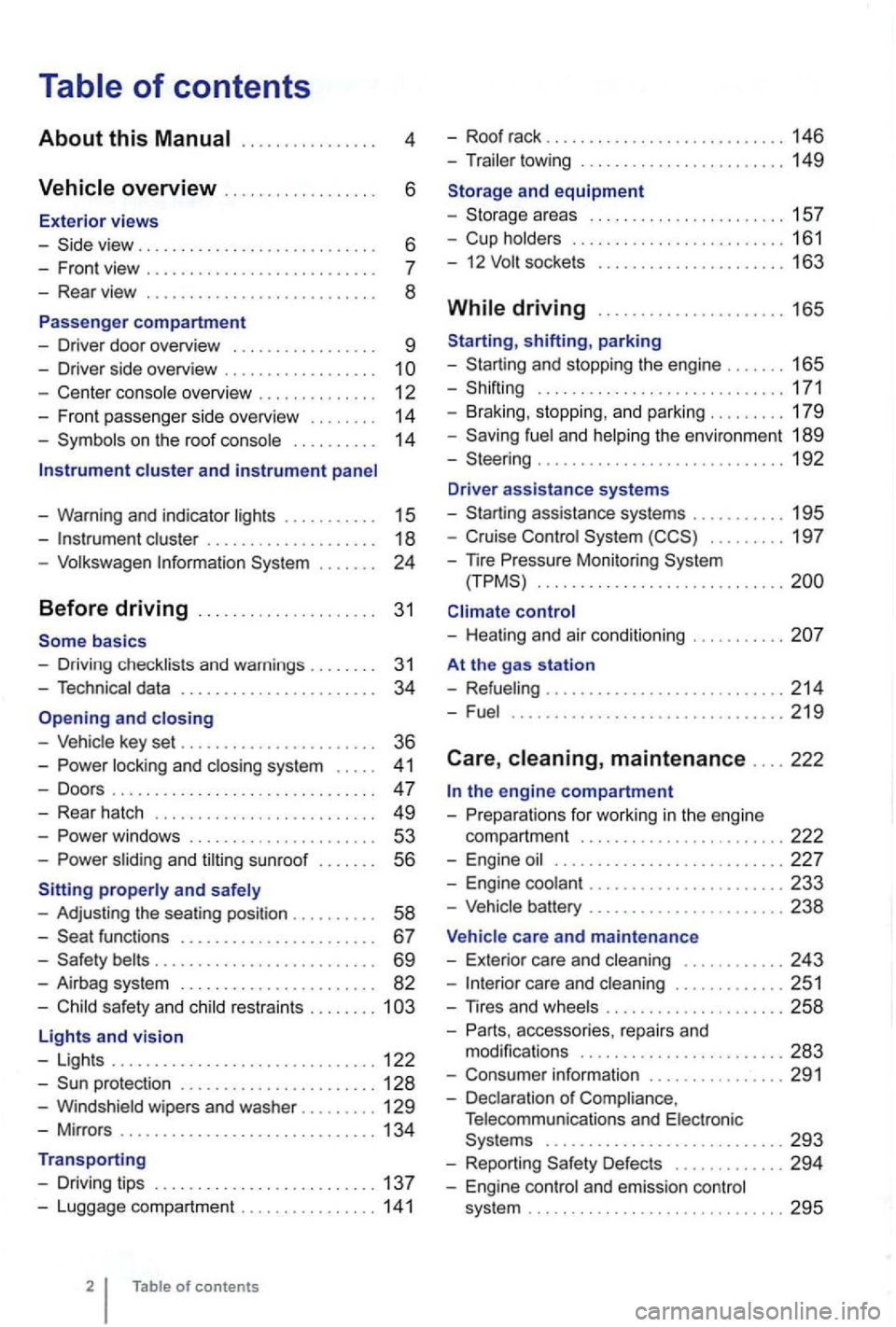
4
. . . . . . 6
- Front view . . . . . . . . . . . . . . . . . . . .
- Center console overview . . . . . . . . . . . . . . 12
- Fron t pa sse nger side overvi ew . . . . . . . .
14
- Symbo ls o n the roo f console . . . . . . . . . . 14
Instrument cluster and instrument panel
- Warning and indica tor
lights . . . . . . . . . . 15
-cluster . . . . . . . . . . . . . . . . . . . 18
-Volk swage n Information System . . .
basics
- Driv ing check lists and warnings .
....... 31
- Techn ical data . . . . . . . . . . . . . . . . . . . . . . . 34
and closing
- Vehic le key set . . . . . . . . . . . . . . . . . . . . . . . 36
-locking and closing system . . . . . 4 1
- Doo rs . . . . . . . . . . . . . . . . . . . . . . . . . . . . . . . 47
- Rear hatch . . . . . . . . . . . . . . . . . . . . . . . . . 49
-. . . 53
-s lidin g and sunroof . . . . . . . 56
properly and safely
- Adjusting the sea ting position . . . . . . .
. . 58
-functions . . . . . . . . . . . . . . . . . . . . . . 67
- Safety . . . . . . . . . . . . . . . . . . . . . . . . . . 69
- Airbag system . . . . . . . . . . . . . . . . . . . . . . . 82
-Child sa fety and child restraints ........ 1
Lights and vision
- Lights ............................... 122
-protectio n ....................... 128
-Windshield wipers and washer ......... 129
-Mir ro rs .............................. 134
Transporting
- Driving tips
.......................... 137
-Luggage compa rtment ................ 141
of contents
- Roof rack . . . . . . . . . . . . . . . . . . . . . . . . . 146
- Trailer towing ...... ............•. .... 149
1 5 7
- Cup holders
......................... 161
- 12
sockets . . . . . . . . . . . . . . . . . . . . . 163
shifting, park ing
- Sta rting and stoppin g
the engin e ....... 165
- Shifting ................... .......... 171
- Brak ing , stop ping , and park ing
......... 179
- Sav ing
fuel a nd helping the environm ent 189
-Steering ............................. 192
Driver assistance systems
- Starting assistance systems
........... 195
-Cruise Control System ......... 19 7
-
nre Mo nitori ng System .............................
control
- Healing and air cond itioning
At the gas station
- Refueling
........................ .... 214
-Fuel ...........................•.... 2 19
Care , maintenance .... 222
fo r work ing in the engin e
compartment
................... ..... 222
- Engine oil ........................... 227
- Engine coolant ....................... 233
-Vehicle battery ....................... 238
Vehicle care and maintenance
- Exteri or
care and cleaning ............ 243
-care and cleaning ............. 251
-
accesso ries, repa irs and
modi fications ........................ 283
- Consumer information ................ 291
- Declaration
of Complia nce,
T elecomm unicat ions and Electro nic
Systems
............................ 293
- Report ing Safe ty Defects ............. 294
- Engin e con trol and emission control
system .............................. 295
Page 114 of 516
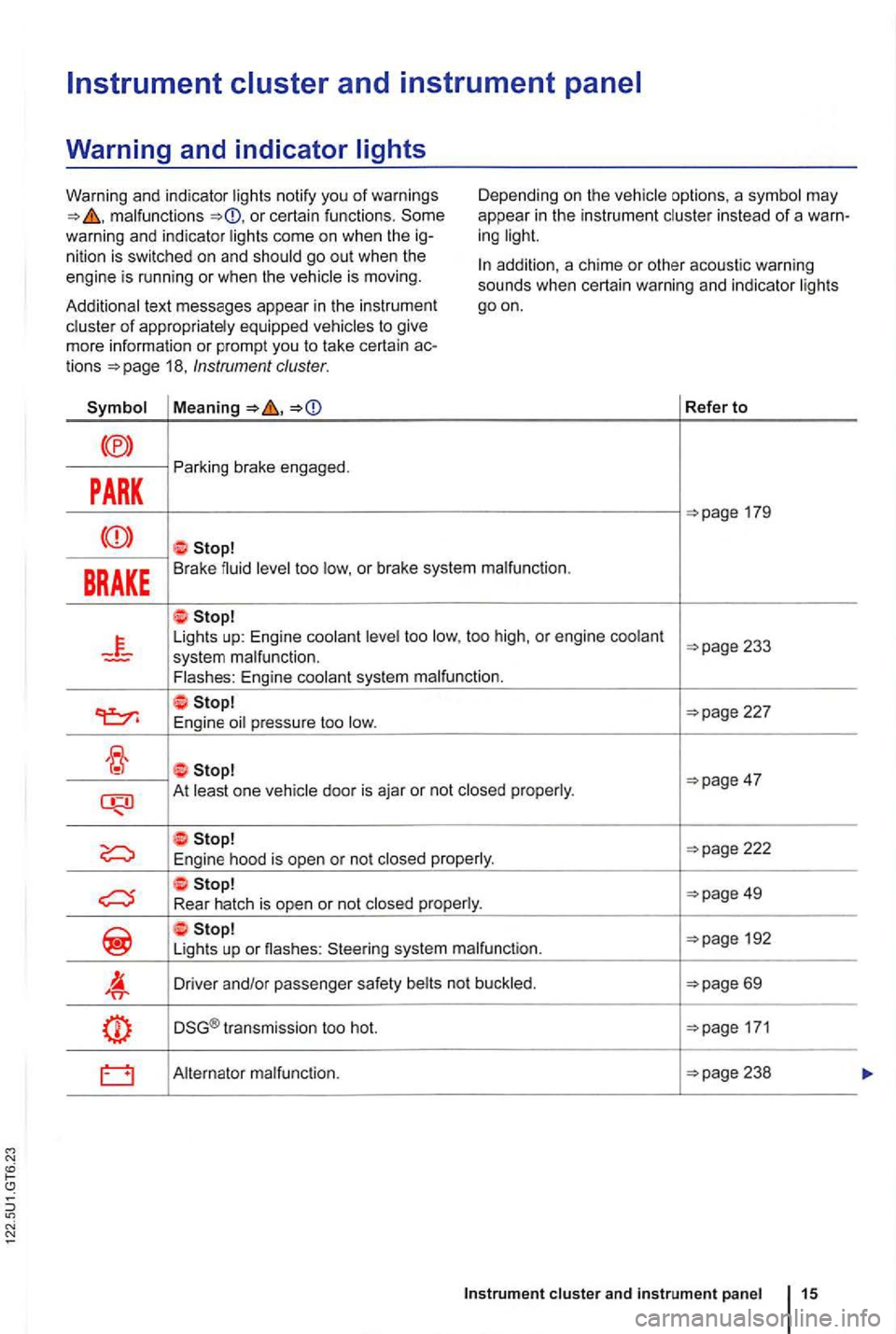
malfunctions or certain functions . Some
warning and indicator ligh ts come on when the ig
nition is swi tched on and shou ld go out when the
engine is running or when the vehicle is moving. D
epending on the vehicle options, a symbol may
appea r
in the instrum en t cluster in stead of a warn
ing light.
Additional text messages appear in th e instrumen t
cluster
of appropriately equipped vehicles to give
mo re information or prompt you to take certain actions 18, Instrument cluster.
addition, a chime or other acoustic warning
sounds when certain warning and indicator lights
goon.
Refer to
PARK
Parking brake engaged.
BRAKE Brake fluid level too low, o r brake system malfunction .
Lights up: Engine coolant level too low, too high , or engine coolant
227
E ngine oil pressure too low.
At least one vehicle door is aja r or not closed properly .
192
Li gh ts up or nashes : Steering system malfunction.
Driver and/or passenger safety belts not buckled .
DSG® transmission too hot. 171
Alternator malfunction.
cluster and instrument panel 15
Page 117 of 516
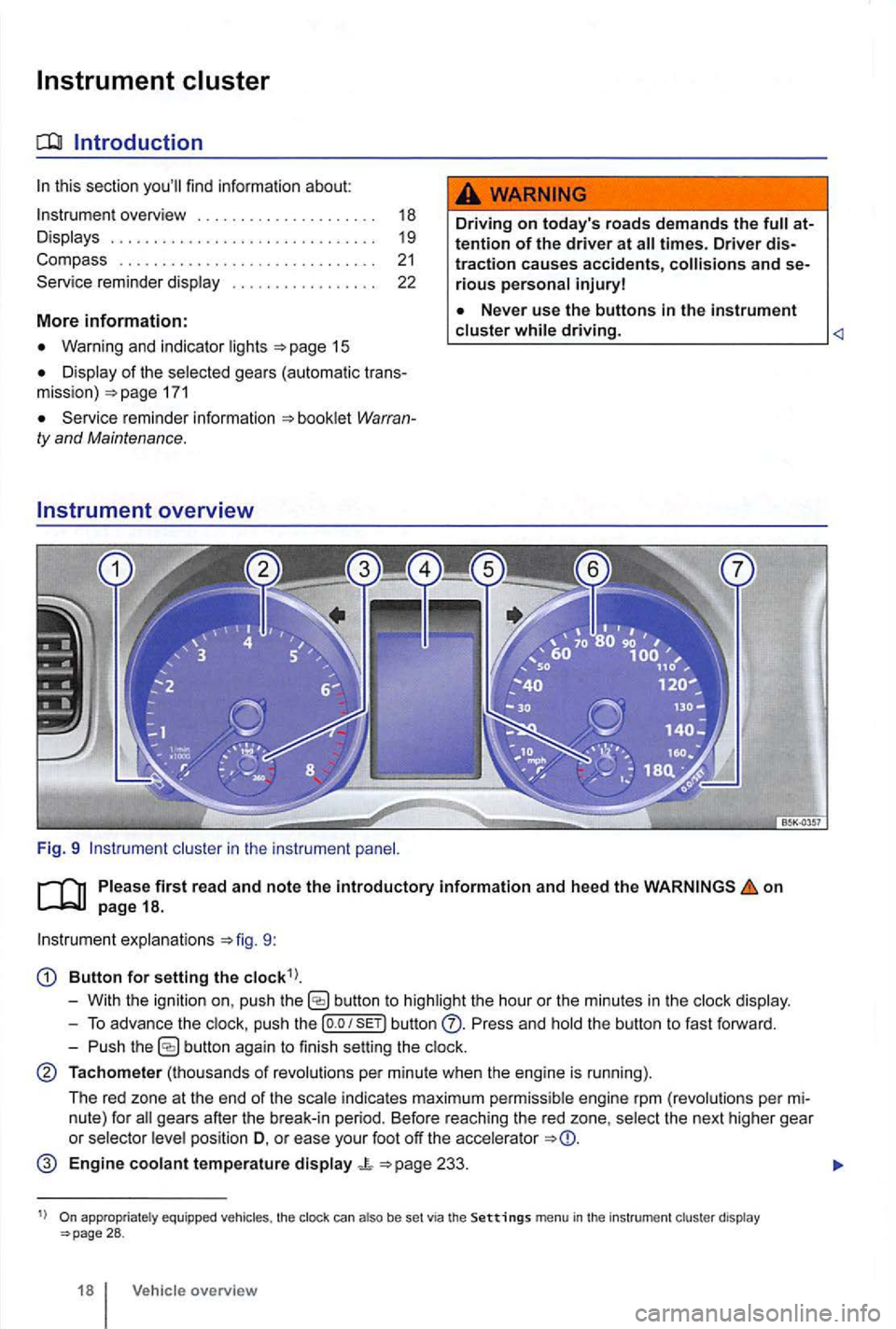
Instrument cluster
Introduction
this section find information about:
overview . . . . . . . . . . . . . . . . . . . . . 18
Displays . . . . . . . . . . . . . . . . . . . . . . . . . . .
. . . 19
Compass . . . . . . . . . . . . . . . . . . . . . . . . . . . . . .
21 Service reminder display . . . . . . . . . . . . . . . . . 22
More information:
Warning and indicator
Display of the selected gears (automatic transmiss ion ) 171
Service reminder inform ation Warranty and Maintenance.
overview
Fig. 9 cluster in the instrument
Driving on today 's roads demands the attention of the driver at
driving.
explanations 9:
Button for setting the
butto n to highlight the hour or the minutes in the
push the button Press and the button to fast forward.
- Push
button again to finish setting the
Tachometer (thousands of revolutions per minute when the engine is running).
The red zone at the end of the
indi cates maximum pe rmi ssibl e engi ne rpm (revolution s pe r
pos ition D, o r ease your foot off the accele rator
Engine coolant temperature display 233.
appropriate ly equ ippe d vehicles , the clock can also be set via the Settings menu in the instrumen t cl uster display 28 .
18 Vehicle overview
Page 133 of 516
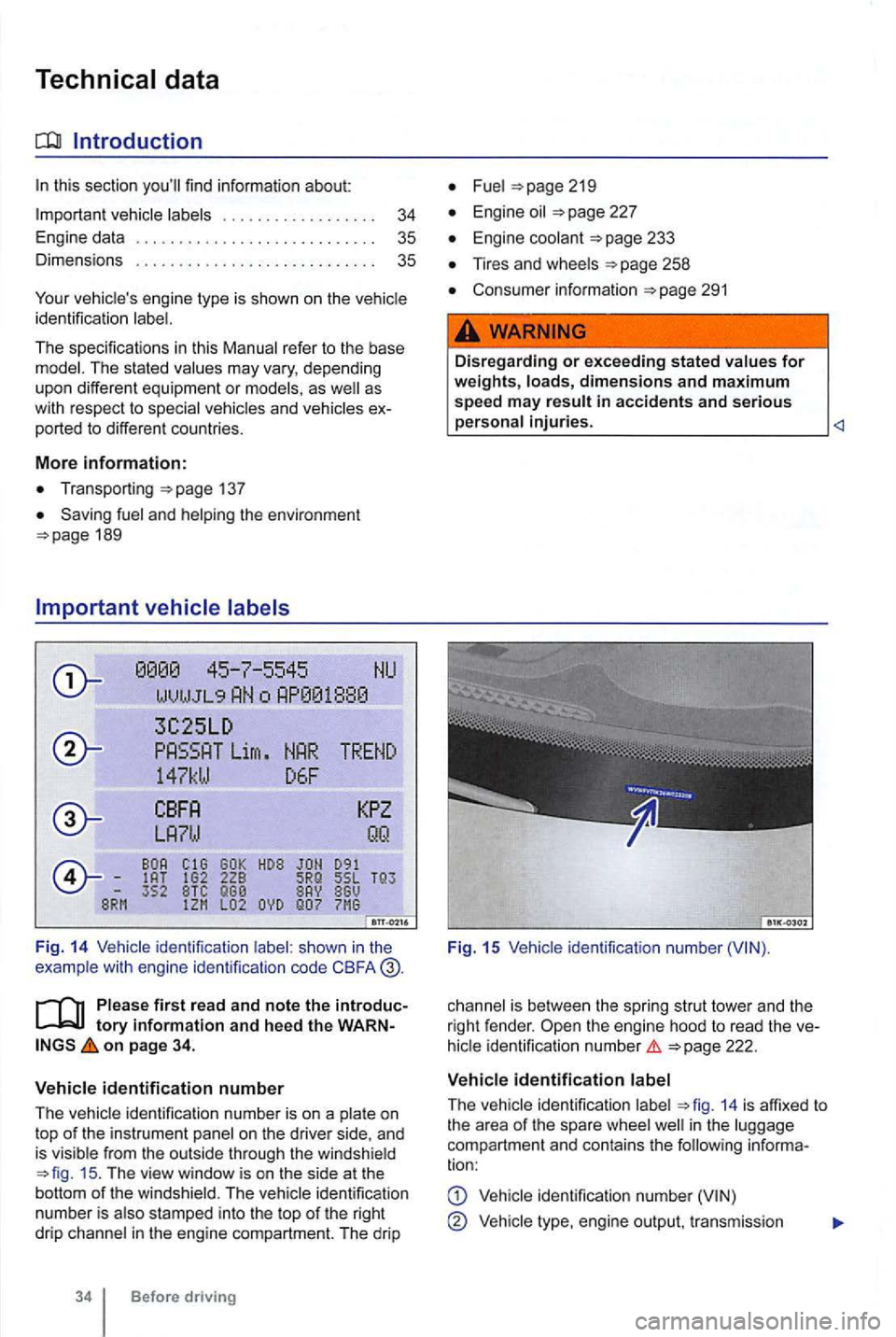
Introduction
137
Saving fuel and helping the environment
WVlJ J L9
3C25LD
Lirn
147kW D6F
352 BTC
F ig . 14 Vehicle identification shown in the
example wit h engine identificalion code CBFA
first read and n ote the int roductory information and h eed t he WA RNon page 34.
V ehicle id entification numb e r
The
ide ntifica tion number is on a and
is visib le from the outside through the windshield 15 . The view window is on the side at the
botto m of the winds hie ld. The identification
n umber is also stamped into the top of the right
drip channel in the engine compartment. The drip
Before driving
Fuel
Engine oil
Engine coolant
Tires and wheels
Consumer informatio n 291
.
Dis regarding or exceeding s tat ed values for weights, loads, dimensions and m aximum speed m ay result in accidents and s erious ____________________
Fig. 15
is bet ween the spring strut tower and the
right fende r.
ident ificat io n numbe r
ide ntification 14 is affixed to
t h e a rea of the spare well in the comp artment an d contains the following informa
tion:
identification number
Vehicl e engine ou tput, tr ansmission
Page 321 of 516

Care,
this sect ion
know how to carry out the
have the correc t technical information and the
proper too ls and supplies, and
are fami liar with the necessary safety precau
t ions
you are uncertain in any
Fa cility. from improperly per
formed work.
More
Exterior views
Windshie ld wipe r and was he r 129
S tart ing and stoppi ng t he engi ne
Brake fluid 179
Vehicle battery
E ngine oil 227
Engin e coolant 233
Parts, accesso ries, repairs and modifications 283
Unintend ed vehicle movement during maintenanc e work can ca use serious personal injuries.
Care , cleaning, maintenance
Never work under the vehicle unless you have safely secured the vehicle from moving. you mus t work under the vehicle with the
wheels on the g round , alway s make sure that the vehicle is on level ground, that
Th e engine compartment of any motor vehicle is a potent ially dangerous area and can cause serious personal injury.
Always use extreme caution when doing any work
Never p erform any work in the engine compartment unless you know exactly how to carry out the job and have the correct tec hnical information and the correct tools .
you are uncertain about what to do, have the work performed by an authorized
Volk swagen dealer, an authorized Volksw a
ge n Service Facility, or another qualified workshop. Serio us persona l injury may result from improperly performed work.
Page 322 of 516

Never open or close the engine hood if To reduce th e risk of electrica l shock and steam or coolant is escaping. Hot steam or personal injury
-Never touch ignition cables. Never ant escaping from the engine. touch other components of the high
Always the eng ine down com-age electronic ignition syste m .
opening the hood.
-Never touch the wiring of the Discharge (Xenon) headlights.
system burn skin on contact.
you are read y to open the hood: Moving parts in th e engine compartment can
- Firm ly apply the parking brake a nd shift cause serious personal injury on contact. the transmission into Park (P) (automatic)
vehicles with Keyless Access, make member that the radiator fan is temperature-
s
ure that the remote contro l vehicle key is controlled and can come on sudden ly even
out of range of th e vehicle and that the ve- when the engine
has been switched off for a
hicl e cannot be started by depres sing the 44. ignition.
-
Always keep children and others away you have to perform a check or repair from the engine compartment and never when the engine is runn ing, there are more leave them unsupervised. risks from the rotating parts, such as the
hair do not get caught in
ries. rotating engine
parts. B efore starting an y
- Turn
the cap
fluids onto hot parts of the engine o r exhaust system can
cause a fire. -
Always use
extreme caution if the ac-
ce lerato r pedal has to be depressed to perform a check. The vehicle will start to move even if the parking brake i s on.
Never leave any objects in the engine compartment, for examp le cleaning rags and tools. Objects left b ehind can cause malfunc-lions, engine damage, and even fires.
High voltage sy stems in the engine com part-ment can ca use electrica l shocks or even
electrocution, severe burns, other serious in-juries, and eve n deathl
Neve r short-circuit the electrica l syste m .
B e especially ca reful when using jumper ca-
Operating fluids and some materials in the engi ne compartment can catch fire easily, causing burns an d other serious personal in-juries
Do not smoke .
b les. The
vehicle 's battery could exp lode! Never work next to open flames or sparks .
223
Page 332 of 516
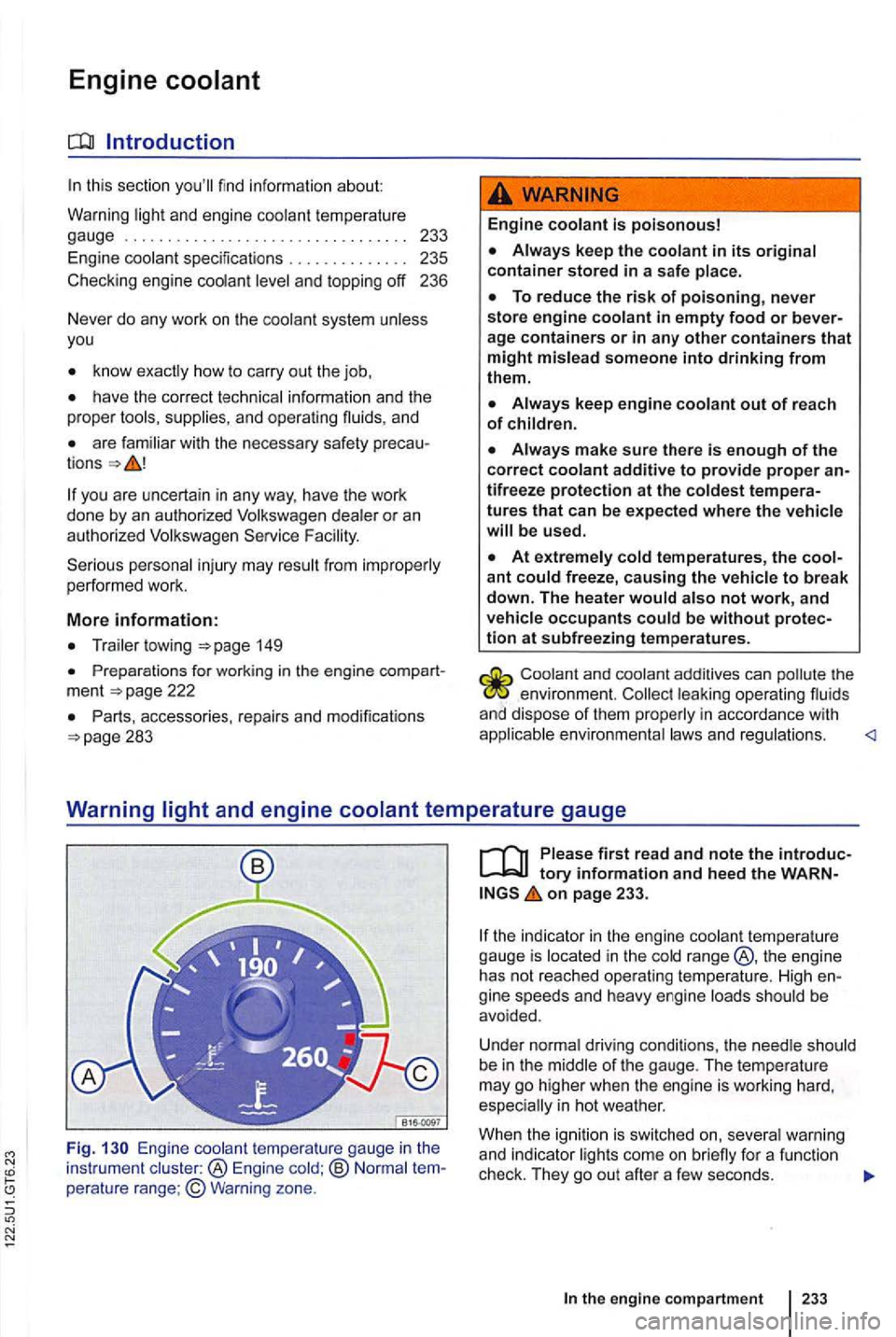
Engine
this section you'll find information about
Warning light and en gine coolant tempe rature
gaug e ................................. 233
En gine coolant spec ifica tions . . . . . . . . . . . . . . 235
Checking engine coolan t level and toppi ng
o ff 236
Ne ver do any work
on the coolant system unle ss
you
know exactly how to carry out the job,
have the correct technical inform ation and the
proper tools, supplie s, and operating fluids, and
are fa miliar with the necessary safety
you are uncertain in any way, have the work
done by an authori zed Volkswage n dea le r or an
a uth orized Volkswagen
in jury may
to wing =>page 149
Preparat ions for work ing in the engi ne page 222
Parts, accesso ries, repai rs and modifications =>page 283
Engine coolant is poisonous!
To reduce the risk of poisoning, never
store engine coolant in empty food or age containers or in any other containers that might mislead someone into drinking from them.
Always make sure there is enough of the correct coolant additive to provide proper tifreeze protection at the coldest tures that can be expe cted where the vehicle will be used .
At extremely cold temperatures, the ant could freeze, causing the vehicle to break down. The heater would also not work, and
vehi cle occupants could be without
Coolant and coolant additives can po llute the en vironme nt. leaking ope rati ng fluids
a nd dis pose of them properly in acco rdance with
applicab le environment al
Warning light and engine coolant temperature gauge
Fig.
perature range;© Warning zone.
first read and note the
on page 233.
the in dicator in the engine coolant tempera ture
gauge is located in the cold range @, the engine
h as not reached operating temperature . H igh
gi ne s peeds and heavy engine loads should be
avo ided .
Under normal driving con
ditions , the needle should
be in the middle of the gauge . The tempe ratu re
may go higher when the engine is working hard, espec ially i n h ot weather.
When
the ign ition is switched on, seve ra l warn ing and indicato r
the engine compartment 233
Page 334 of 516
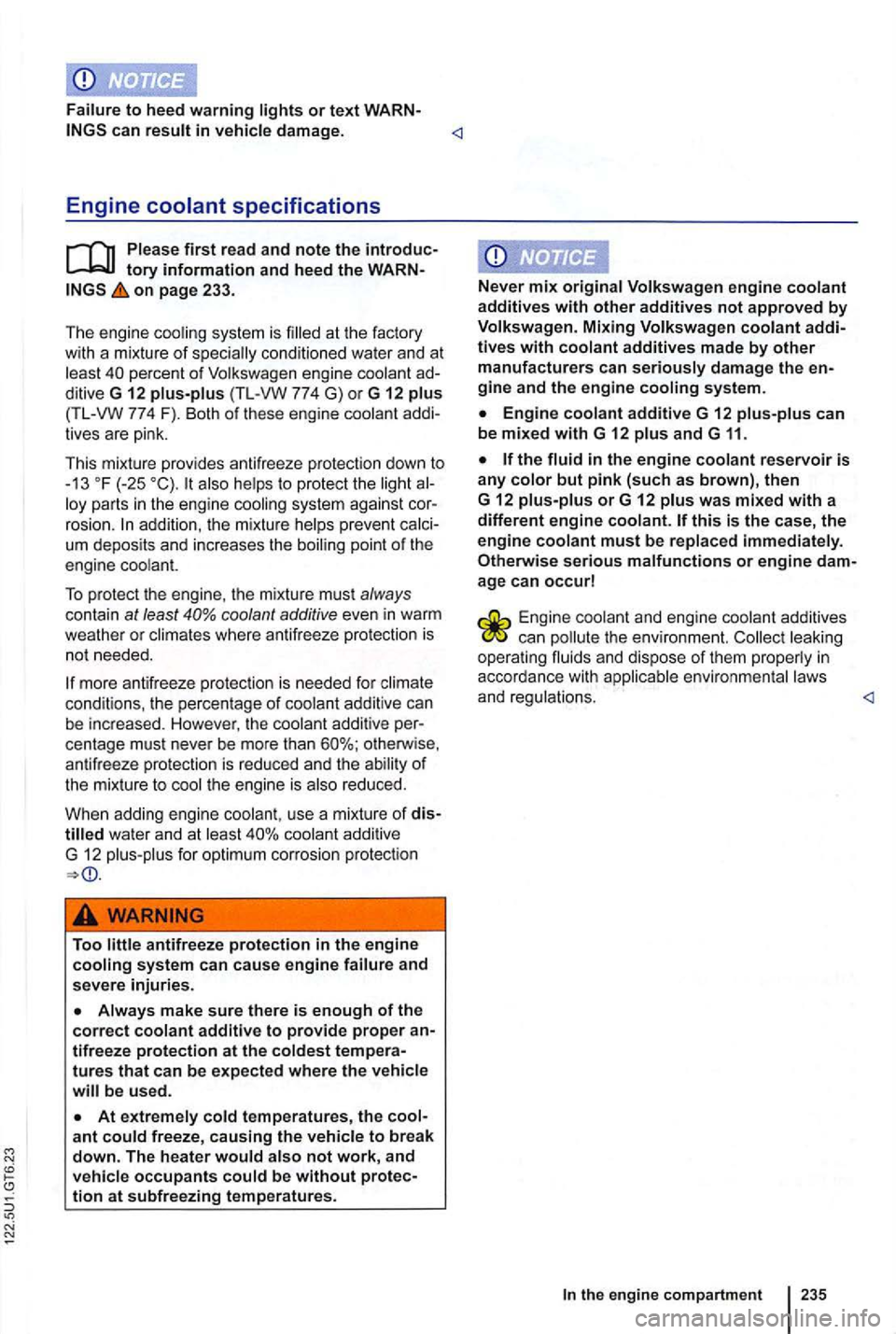
Failure to heed warning lights or text WARN-can result in vehicle damage.
on page 233.
Th e engine cooling system is
loy parts in the engine cooling system against ros ion. addition , the mixture helps prevent
coolant additive even in warm
weathe r or climates where antifreeze protection is
not needed.
otherw ise ,
antifreeze protection is reduced and the ability of the mixture to cool the engine is also reduced.
When
adding engine coolant, use a mixture of tilled water and at least coolant additive
G 12 pius-plus for optimum corrosion protection
.
Too little antifreeze protection in the engine cooling system can cause engine failure and
severe injuries.
tures that can be expected where the vehicle will be used.
ant could freeze, causing the vehicle to break down. The heater would also not work, and vehicle occupants could be without
gine and the engine cooling syste m.
can pollute the environment. Collect leaking
operating fluids and dispose of them properly in
accordance with applicable environmental laws
and
regu lations .
Page 335 of 516
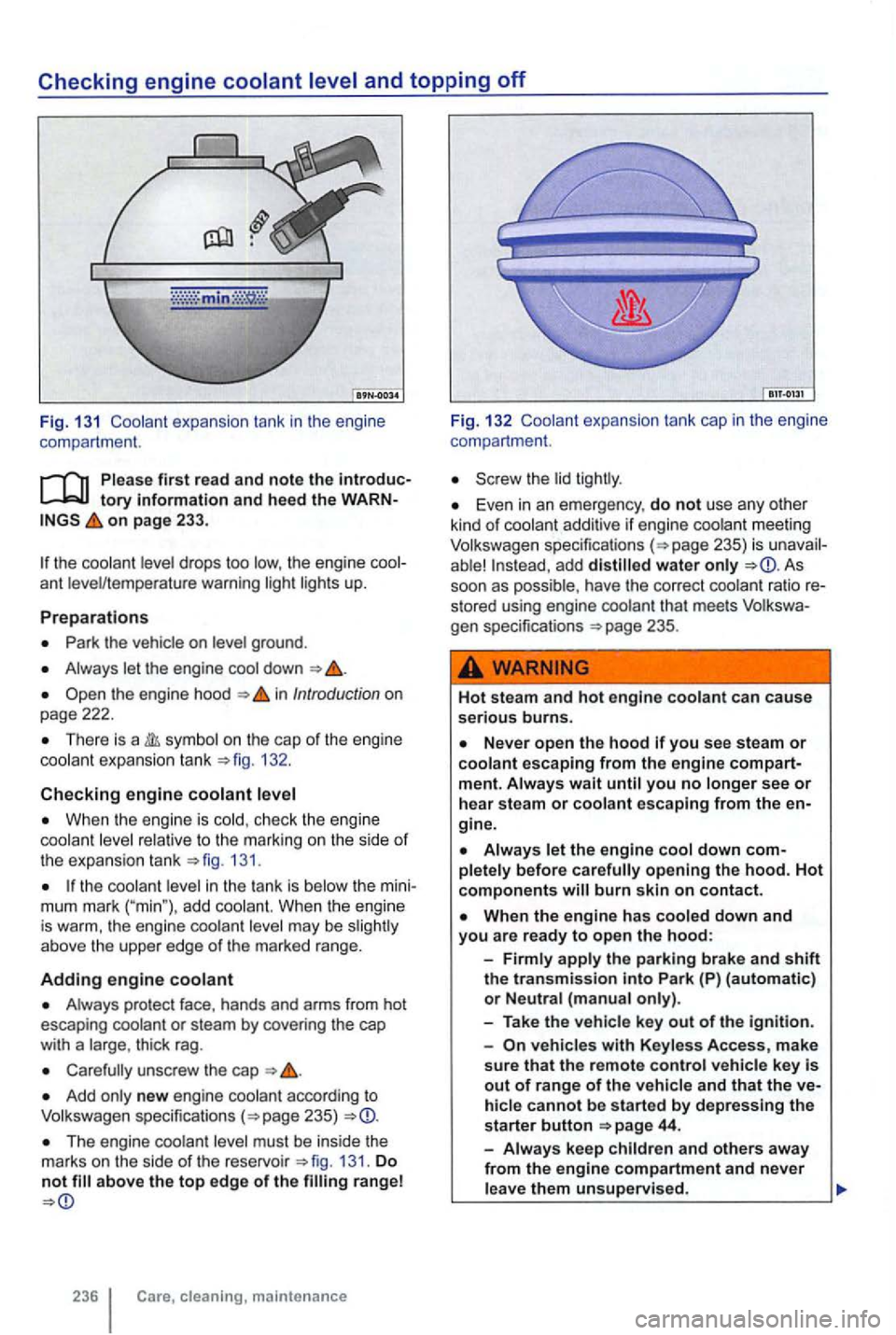
Checking engine coolant level and topping off
Fig. 13 1 Coolant expan sion tank in the engi ne
compartme nt.
Please first read and note the introductory Information and heed the WARN on page 233.
Park the vehicle on level ground .
Always let the engine down
the engine hood in Introduction on
page 222.
There is a sy mbol on the cap of the engine coolant expans ion tank 132 .
Checking engine coolant
When the engine is cold , check the engine
coolant level relative to the marking on the side of the expansion tank 13 1.
the coolant level in the tank is below the mini
mum mark ("min"), add coolant. When th e engi ne is warm, the engine coolant level may be slig htly
above the upper edge of the marked range.
Adding engine coolant
Always protect face, hands and arms from hot
escaping coolant or steam by covering the cap
with a large , thick rag.
Carefully unscrew the cap
Add only new engine coolant according to
The engine coolant level must be inside the
marks on the side of the reservoir 131. Do not
236 cleaning, maintenance Fig.
132 Coola nt expansion tank cap in the eng ine
compa rtment.
Screw the lid tightly .
Even in an emergency , do not use any other kind of coolant additive if engine coolant meeting
add distilled water only As
soon as possible , have the correct coolant ratio re
sto red using engine coolant that meet s
WARNING
Hot steam and hot engine coolant can cau se serious burns.
Neve r open the hood you see steam or coolant escaping from the engine compartment. Always w ai t until you no longer see or hea r steam or co olant escaping from the en
gine .
opening the hood. Hot components will burn skin on contact.
Park (P) (automatic) or Neutral (manua l only).
- Take the vehicle key
out of the ignition.
-
veh icles with Keyless Access, make
sure that the remote control vehicle key is out of range of the vehicle and that the vehicle cannot be sta rted by depressing the
starte r button 44.
-
Always keep children and others away
from the engine compartment and never
l eave them unsupervised.
Page 336 of 516
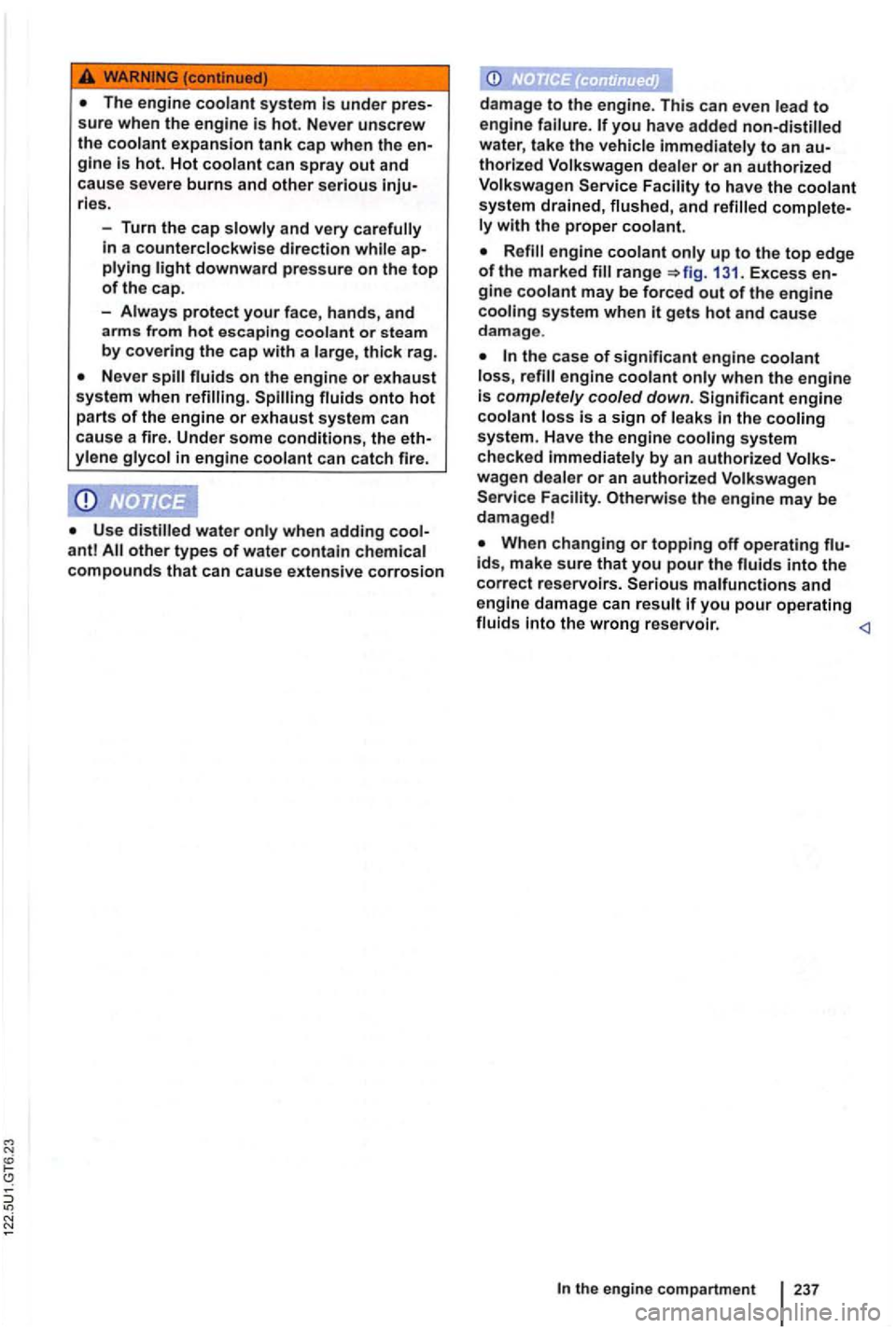
under pres
sure when the engine is hot. Never unscrew the coolant expansion tank cap when the en
gine is hot. Hot coolant can spray out and
cause severe burns and other serious injuries.
-Turn
the cap slowly and very carefully
Use distilled water anti
damage to the engine. This can even to engine failure.
Refill engine coolant up to the top edge of the marked
when the engine
is completely cooled down. Significant engine coolant Joss is a sign of leaks
you pour operating
fluids the wrong reservoir.